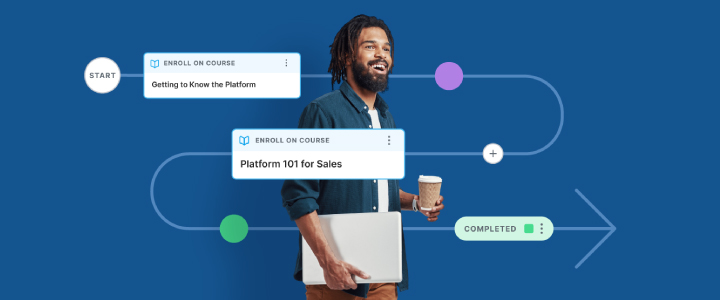
4 min reading time
11 Training Survey Questions You Should Be Asking
Seasoned L&D teams understand that the work doesn’t end at the completion of a training program. An essential part of continuous improvement often comes in the form of post-training surveys. And while the process of creating survey questions might not always get the priority they deserve, selecting the right training evaluation questions is critical to extracting important insights and feedback from those who just participated in the training.
To help streamline the process of building out your next survey, and to maximize training effectiveness, we’ve compiled a list of eleven questions that can help your team achieve a deeper understanding of what is working, what could be improved, and ultimately what’s necessary for your organization to become a learning organization.
1. Did the training meet your expectations?
This question is a good one to include toward the beginning of the survey, since it’s relatively open-ended and can help “warm up” the survey participant. In the event that their answer isn’t a direct “yes”, it can be an indication that you might need to improve the process of setting expectations during pre-training communications. Take a look at our post on the 7 employee training expectations for more insight into the mind of a learner.
2. Was your trainer supportive and engaging?
While the first question asks the participant to evaluate their experience more broadly, this follow-up question helps to narrow the focus around the trainer specifically. After all, employee development doesn’t just apply to those receiving the training, but everyone involved in the process. Check out our post on the qualities required to become a good trainer.
3. Was the included material engaging?
Many of us have had the uncomfortable experience of attending a virtual meeting with minimal engagement. In short, “engagement” is a way to determine whether a participant feels a connection to the training material. And similar to attending well-planned online meetings, engaging learning content leaves participants feeling that their time was spent productively, and encourages them to embrace future training opportunities.
4. Was the training platform easy to use and understand?
Online platforms have matured rapidly over the past few years, and most of us have little patience for applications that are slow, confusing or unresponsive. It’s of the utmost importance that you choose an LMS that includes all the modern features that you need, while at the same time delivering an experience that’s fast, easy to use, and doesn’t detract from the training content itself.
5. Was the training material relevant to your role and/or position?
While the previous questions have asked the participant to evaluate the quality of their training, this question shifts the goalposts slightly by asking them to consider relevancy. The purpose surrounding this question is important to dissect: it’s possible to provide high quality, engaging training, but still miss the mark on relevancy. Once again, this is likely to cause participants to feel like their time wasn’t respected, so determining if they felt a disconnect between the content and their role is an important nuance. In short, unlocking the answers to these types of training survey questions has many benefits for employee development as it enables you to provide them with an experience that’s both engaging and relevant.
6. Was there any part of the training that surprised you?
This gives the survey participants the opportunity to inject some creativity into their answer, and also encourages them to identify the material they connected with most. The answers to this question can surface if there’s a section that’s resonating more with participants overall, or if there’s a section that might need additional refinement to be more engaging.
7. What are your desired goals from completing this training?
This question asks trainees to look to the future and evaluate how they will apply the training content. Their answer can help determine if personal goals are aligning with company goals across your organization, and also reveal important trends across participants. This question also helps to reinforce that the purpose of the training is self-improvement, which can hopefully increase enthusiasm for future training opportunities.
8. Did the time required to complete the training align with your expectations?
Training length (either real or perceived) can be a common area of friction among participants. Engaging training content should cover all necessary material without feeling like it’s being too repetitive or not respecting the time of participants. While expectations can vary across participants, the perception of time can actually reveal more than the actual minutes on the clock.
9. If you could change one thing about the training, what would it be?
This provides the opportunity to share valuable, open-ended feedback about the training. This question is sort of a “catch all” to identify points of friction around the content, LMS, or overall training experience. Answers to this question are likely to inspire follow-up conversations, especially with survey participants whose answers are detailed or opinionated.
10. Which topics would you like to learn more about?
The answers to this question can be extremely valuable for L&D teams to identify possible gaps in their training strategy, and also uncover trends across participants. Similar to the question above, answers that are especially detailed are a good indication that follow-up conversations with the participant could be extremely valuable in surfacing additional insights to shape future training.
11. Would you be willing to offer thirty minutes of your time to help shape future training experiences?
If previous answers didn’t uncover which participants are willing to play an active role in future training, this question asks directly. Employees who are willing to share detailed feedback are extremely valuable, and it’s important to act quickly after the training to schedule follow-up conversations while the experience is fresh in their mind. Not only will these discussions help you shape your L&D strategy, but employee engagement is a great way to encourage a learning culture among employees.
The importance of continuous improvement
Continuous improvement and personal growth are two key tenets at the core of most training strategies, and it’s important that L&D teams take these values to heart as they work to improve the training experiences they’re offering to employees. Asking effective, direct training survey questions is a crucial part of the process, as is thoroughly reviewing survey answers to develop and improve future trainings. This continuous refinement can help L&D teams better align their learning strategy with company goals, and ultimately maximize the value they’re providing.
Check out our post on how to create a training evaluation form here. We’ve also included a free downloadable template to help you kickstart the process.



